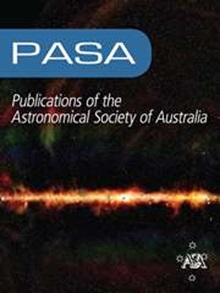利用混合密度网络恢复银河三维形状
IF 4.6
3区 物理与天体物理
Q1 ASTRONOMY & ASTROPHYSICS
Publications of the Astronomical Society of Australia
Pub Date : 2024-04-18
DOI:10.1017/pasa.2024.32
引用次数: 0
摘要
自本世纪初以来,天文学家一直在利用恒星运动图和成像相结合所提供的丰富信息,试图恢复星系的内在三维(3D)形状。一种常见的固有形状恢复方法依赖于运动学轴和形态学轴的固有错位与三轴性参数之间的预期单调关系。然而,最近的研究对有关形状和固有运动错位的基本假设提出了质疑。在这项工作中,我们的目标是利用混合密度网络(MDN)的监督机器学习方法,通过投影的恒星运动学和通量分布来恢复单个星系的三维形状。利用 EAGLE 流体动力宇宙学模拟的模拟数据集,我们针对精心挑选的一组常见运动学和光度学参数训练了 MDN 模型。与以前的方法相比,我们展示了 MDN 模型在检索三维星系形状和不确定性方面的潜在改进,特别是对于长轴星系和三轴星系。我们为当前和未来的积分场光谱星系测量提出了恢复星系固有形状的具体建议。本文章由计算机程序翻译,如有差异,请以英文原文为准。
Galaxy 3D Shape Recovery using Mixture Density Network
Since the turn of the century, astronomers have been exploiting the rich information afforded by combining stellar kinematic maps and imaging in an attempt to recover the intrinsic, three-dimensional (3D) shape of a galaxy. A common intrinsic shape recovery method relies on an expected monotonic relationship between the intrinsic misalignment of the kinematic and morphological axes and the triaxiality parameter. Recent studies have, however, cast doubt about underlying assumptions relating shape and intrinsic kinematic misalignment. In this work, we aim to recover the 3D shape of individual galaxies using their projected stellar kinematic and flux distributions using a supervised machine learning approach with mixture density network (MDN). Using a mock dataset of the EAGLE hydrodynamical cosmological simulation, we train the MDN model for a carefully selected set of common kinematic and photometric parameters. Compared to previous methods, we demonstrate potential improvements achieved with the MDN model to retrieve the 3D galaxy shape along with the uncertainties, especially for prolate and triaxial systems. We make specific recommendations for recovering galaxy intrinsic shapes relevant for current and future integral field spectroscopic galaxy surveys.
求助全文
通过发布文献求助,成功后即可免费获取论文全文。
去求助
来源期刊
CiteScore
5.90
自引率
9.50%
发文量
41
审稿时长
>12 weeks
期刊介绍:
Publications of the Astronomical Society of Australia (PASA) publishes new and significant research in astronomy and astrophysics. PASA covers a wide range of topics within astronomy, including multi-wavelength observations, theoretical modelling, computational astronomy and visualisation. PASA also maintains its heritage of publishing results on southern hemisphere astronomy and on astronomy with Australian facilities.
PASA publishes research papers, review papers and special series on topical issues, making use of expert international reviewers and an experienced Editorial Board. As an electronic-only journal, PASA publishes paper by paper, ensuring a rapid publication rate. There are no page charges. PASA''s Editorial Board approve a certain number of papers per year to be published Open Access without a publication fee.

 求助内容:
求助内容: 应助结果提醒方式:
应助结果提醒方式:


